There Is No Spoon
Doctor Who: The Bells of Saint John
meta, mythology, monsters, mirrors, memory
and lots of pics, perhaps even some chairs
spoilers through the episode, obvs
Mmmmm.
The Question of Identity is one of the central concerns in Moffat's era, and The Bells continues along this particular thread. And answering this question is one of the central functions of Mythology -- because who we are isn't such an easy question to ask after all. So much of who we are is buried in the subconscious mind, where memories and monsters reside, not always directly accessible to the conscious mind. It takes a special mirror to draw this material out, a mirror that helps us look sideways, out the corners of our eyes.
This is why we have monsters in our myths. Monsters are drawn up from the subconscious and made flesh, a way to represent the more abstract forces that churn away down below. Once you get a monster out in the open, you can deal with it. Those monsters can be collective (like Daleks representing the terror of fascism) or individual and personal -- think of Chloe Webber's father in Fear Her. And sometimes they can be a combination thereof -- the AmyBot of Let's Kill Hitler stands both for Amy's emotional shutdown in the face of losing her baby daughter, but also as the implacable machinery of punitive justice, and all the "sanctions" and "privileges" that complicate it.
But what happens when we tap into the software running underneath the hood? Face those monsters, recover those memories, and somehow manage not to fall completely apart -- or, barring that, somehow manage to put ourselves together? Becoming fully integrated, where the polarities of self are fused into a singular whole, might feel like Death and Rebirth, a taste of what's to come at the end of every story.
And boy, does this episode cover that territory in spades! Or spoons, if you prefer.
Attack of the Mirror-Monsters
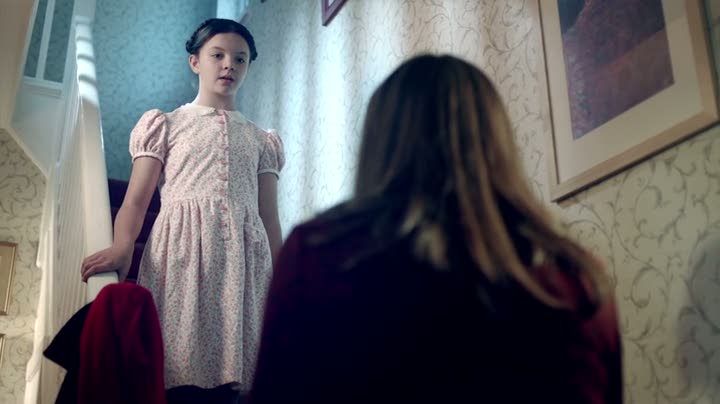
CLARA: Hello?
LITTLE GIRL: Hello.
CLARA: Are you a friend of Angie's?
LITTLE GIRL: I'm a friend of Angie's.
CLARA: What were you doing upstairs?
LITTLE GIRL: I was upstairs.
CLARA: I know you, don't I?
LITTLE GIRL: You know me, don't you.
So, a bit about mirrors. Mirrors reflect images of ourselves back to us -- that's our primary, historical use of mirrors, the construction of lasers, holographs, and quantum physics experiments notwithstanding. So we use them to locate a sense of identity, an aspect of self-consciousness, but with a price: the image we see is reversed.
The Spoonheads are mirror-monsters in many senses. First is their use of dialogue. The Little Girl who confronts Clara on the staircase (a staircase being a symbol for Ascension) echoes Clara, but with a twist: her questions are made into statements. Chilling statements.
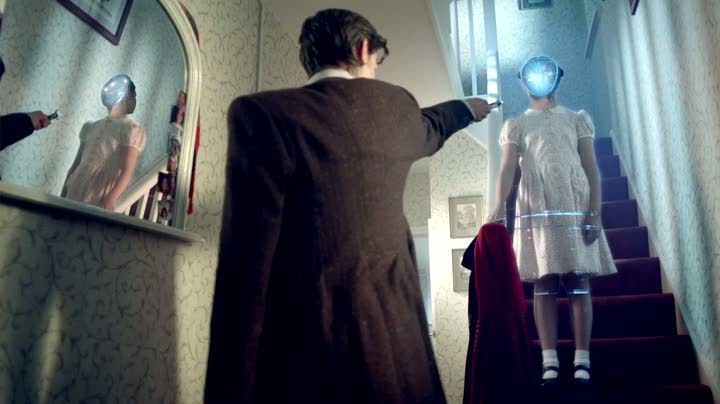
DOCTOR: It must have taken an image from your subconscious and thrown it back at you.
The Spoonheads are Mirror-monsters in a visual sense as well. They literally are reflections of the subconscious, thrown back at us, again with a terrible reversal -- they present not as monsters, but as trusted figures, to some extent. Maybe the people we want to trust, but don't quite yet. And rather than holding up a mirror to show you who you are, they hold up a mirror and suck you into their spoon-heads, and suddenly you don't just not know quite who you are, you can't even imagine where you are. This is what it means to be lost.
And yet it's not impossible to retain an inkling of self-consciousness through this process. Nabile, the guy with the twitter and youtube warnings and who narrates the opening sequence, is prescient enough to know how he's gotten lost, lost in the WiFi. He equivocates this with being dead... for a while. And though he still doesn't know where he is, he knows enough to try and warn other people of what's going on. It's a dead-end message, but it's selfless enough that he's granted narratorial privileges!
With that in mind, let's go back, all the way to The Library:
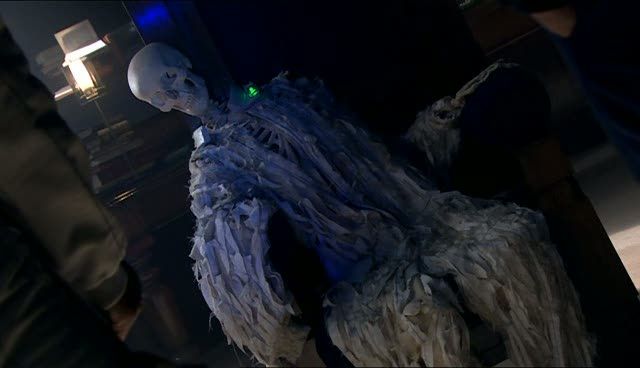
The people in the Library all tried to teleport out when the Shadows came -- and they caught in the Wifi and uploaded to CAL's data core. Three generations later, River brings an archeological expedition back to sort it all out, and the first member of this group to die is Miss Evangelista. She starts "ghosting" thanks to her "neural relay" and one of the first things she asks is "Where am I?" At first she can't see anything, but once she's uploaded and her intelligence is given an artificial boost she's able to see what no one else in the Library can see -- where she is, not to mention who she is, for she remembers everything. In that virtual reality, she's presented as a veiled monster, and as such works on Donna to help her understand where and who she is as well.
Okay, enough of The Library.
Clara's first mirror-monster, don't forget, is a Little Girl, who's drawn from a Book:
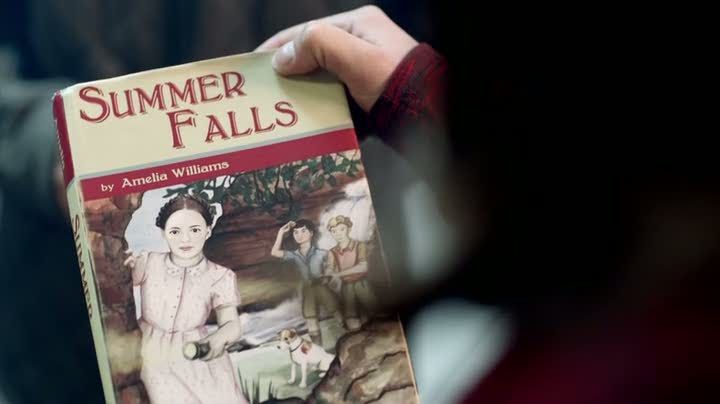
And of course the book has clues, subconscious reflections not just of Clara's but of the show itself. This book is a very self-conscious prop. First, it's written by Amelia Williams, our very own Amy Pond, so it's an emanation of the Doctor's latest loss, not to mention the picture on the cover has a River running through it. The title, "Summer Falls," plays off "The Rapture of Summer" which was written on a Chinese vase back in Angels Take Manhattan, and the "fall" of summer is a reflection of the declaration that "Winter is Coming" in The Snowmen.
On top of it, Clara says to Angie that while Chapter Ten is good, "Eleven's the best -- you'll cry your eyes out!" A nod to one of the primary aesthetic concerns of the current era. Best of all, this book will be available as an honest-to-goodness piece of (electronic) fiction on April 4th.

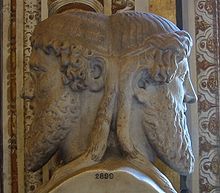
The silvery mirror-like "spoon" of the monster is located in the back of the head -- not the front, where the conscious mind "operates" for lack of a better word. Rather than the monsters residing in our subconscious mind, we end up residing in theirs. Which is kind of clever, considering that the Doctor himself is supposed to be the monster that gives other monsters nightmares. So here's a big reversal, which is rather apt considering that mirrors reverse images.
It's also a representation of "fusion" technology. Clara's consciousness becomes disembodied (not unlike The Great Intelligence) and "fused" into the "bay server" of the Spoonhead. The Spoonhead ends up having two faces -- Clara's in the back and the Little Girl's in front, with the entire head reversed. Very alchemical.
It's a symbolism that's not unfamiliar in mythology. JANUS was a roman god of beginnings and endings, looking to the past and the future simultaneously. This is, notably, the same function of The World Tree.
The etymology of Janus interests me. Paul the Deacon suggests this god's name derives from "Chaos" -- which is apt for the Doctor, considering he's a mercurial anarchist. Nigidius Figulus suggests it's a fusion of Apollo and Dianus, and hence the Sun and Moon, day and night, conscious and subconscious faces. Again, apt for the Doctor, especially considering the symbolism of the Impossible Astronaut, an Apollo who goes to the Moon. Cicero and Ovid think it's derived from the word "to go" -- Allons-y!
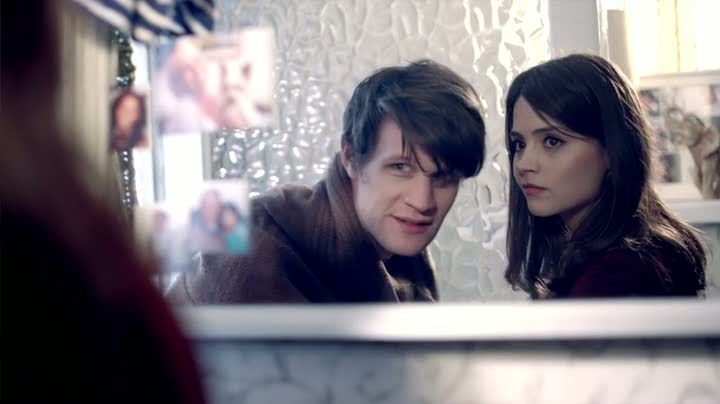
DOCTOR: Do you remember me?
CLARA: No. Should I? Who are you?
DOCTOR: The Doctor! No? The Doctor?
CLARA: Doctor Who?
It's possible for self-consciousness to be a repellent, at least for some fans of certain TV shows. The problem with the quest to understand the question of Who Are You? is that it can feed the Ego, which paradoxically runs counter the selflessness that's necessary to break through to the subconscious mind. It's completely the wrong approach, then, for the Doctor to succumb to his vanity when he answer's Clara's call to adventure and comes a' knockin', much too self-centered, and it nearly costs Clara her life.
Well, it does cost her life, insofar as getting sucked up by a Spoonhead renders one "dead" -- until the Doctor gets her back into her body.
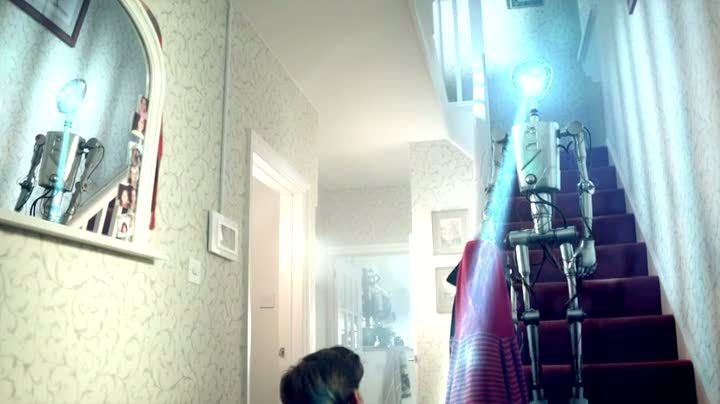

So, Clara "dies" and is "saved" using imagery and sound effects that harken back to The Girl Who Waited, where the Voice Interface gave Amy Pond a new lease on life, as well as peaceful remembrance upon her final demise that a different version of herself might live.
Meanwhile, in Chiswick (?) we have the Doctor carrying Clara upstairs and tucking her into bed, where she will eventually awaken to Jammie Dodgers and a nice vase of flowers, "reborn" as a brand-new person -- for now she's not just fiercely clever, but possesses mad computer skillz as well. Fitting, then, that she adopts a new name "Oswin" to express this new aspect of Self.
And then she dies again, having risked being found by the monsters when she hacks into their computer to find out where they are. And where they are is The Shard, which is a Glass Mirror Mountain (again with The Girl Who Waited!) and which was "suggested" by the promo pics where monsters are reflected in shards of glass flying about all over the place, thanks to the Doctor on his Triumph.
The Doctor Monster
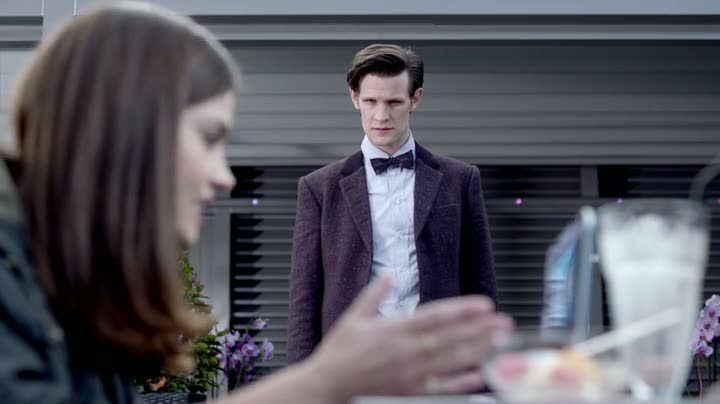
CLARA: I did it, I really did it! I found them!
SPOON!DOCTOR: Found them.
CLARA: The Shard. They're in The Shard. Floor Sixty-Five.
SPOON!DOCTOR: Floor Sixty-Five.
CLARA: Are you listening to me Doctor? I found them!
SPOON!DOCTOR: I'm listening to you. You found them.
So here we get another Mirror-Monster, this time in the form of the Doctor, using mirror-dialogue. And I'm tempted to read this as representing some of the Doctor's darkest aspects -- the monstrosity that lurks within him. Because the Doctor is the monster that other monsters fear. And what, exactly, is the monstrosity that the Doctor possesses?
He's a mirror. He has the power to Reverse The Polarity. He holds up a reflection that monsters can't bear to witness, because it means acknowledging their own monstrosity.
Now, before Clara, the Doctor wasn't the only protagonist to be "monstered" -- ever since The Big Bang, that's a function that Amy Pond fulfilled as well, whether it was shooting her daughter, fighting as a pirate, becoming a wooden doll-monster, shooting the Doctor in the head with a stun gun, being depicted as a Flesh monster, and of course her time as the Tesselecta. So it's interesting that this dynamic continues with Amy, even after she's gone. I'm referring to the Little Girl on the Staircase, whose countenance appears on Amy Pond's book.
Even Clara's been "monstered" in her first two appearances. In the Asylum, she was a full-blown Dalek. In The Snowmen, she's juxtaposed with the Governess. But in The Bells, she steps out of that role, and her reflections take on the aspect of foreshadowing instead, as if she were, in some respects, a prophet.
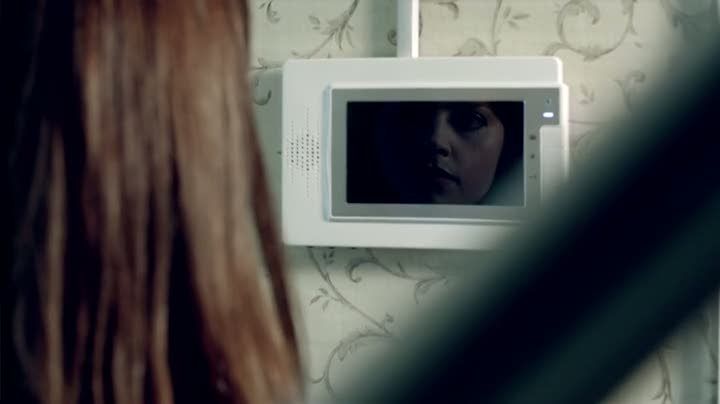
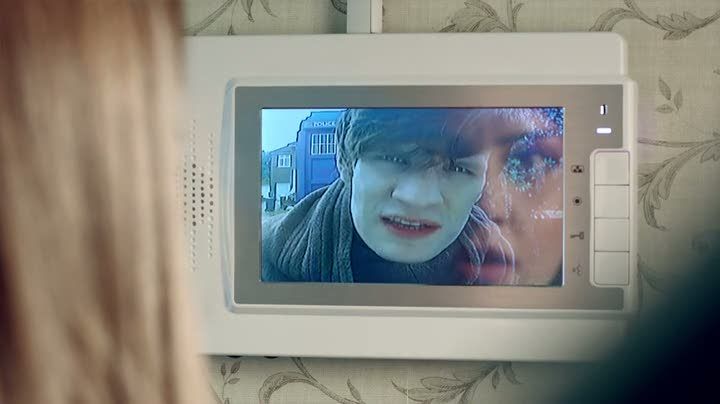
In the above shot, Clara's face is reflected in her security system. Now, this is the kind of imagery that's already been used to show us people who've been caught in the WiFi, uploaded to Spoonheads. And this indeed is what will happen to Clara.
But then something different happens -- the Doctor's image comes on the viewscreen, and his face is superimposed with Clara's reflection, which now seems more like a ghost than a video image. And it's particularly interesting given the second time Clara gets hoovered up by a walking mirror:

The Doctor-Monster has become "fused" with Clara's image. And this is rather apt, because Clara's been haunting the Doctor for a while now. She's died twice, which certainly made an impression on him. After he failed to find her, he retreated to a monastry and painted her image while waiting for her to call. She literally made him wait. Interesting. The Doctor doesn't like to wait.
That's not the only thing here the Doctor doesn't like. In particular, he doesn't like people getting hacked, getting "rewritten" -- but this is something he's done himself. And as one of the things hanging on his conscience, it comes up front and center as we race toward the climax of the story.
First things first, though.
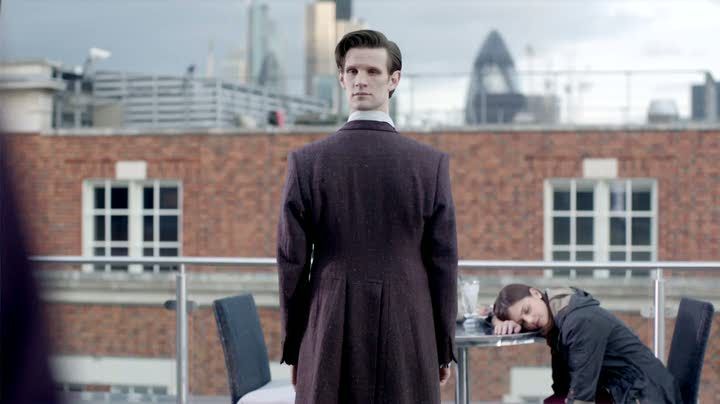
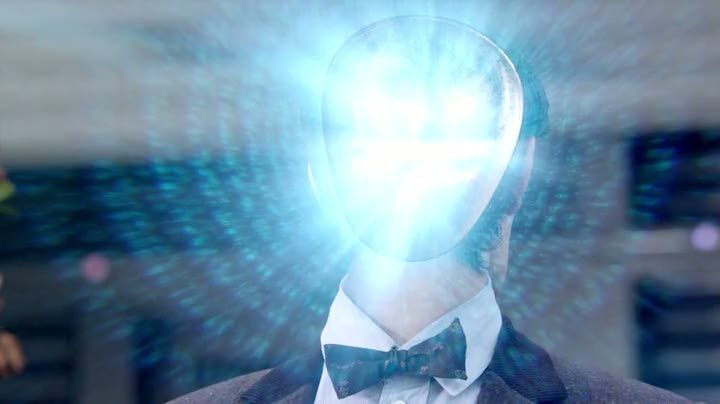
The Doctor has to face himself, looking forwards and backwards at the same time (and my Goddess that's a beautiful coat!) to see what he's become, and integrate this sense of self as a part of Who He Is.
The imagery on the right suggests that one part the Doctor plays is to act as a source of Enlightment. Look how he shines! And in so doing, it's suggested that the "near-death experience" that's often a part of "Ascension," namely the trope of traveling through a tunnel to the Light, is something that happens in the back of the head, that this is part and parcel of tapping into the subconscious mind unrestricted. It's a terrifying experience, looking into the mirror of the Self and seeing the monstrosity within, which is why this kind of imagery has to be linked with the Doctor-Monster.
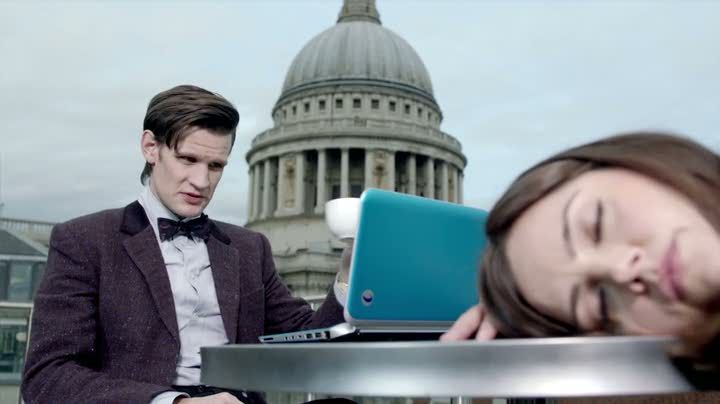
Once the Doctor's figured himself out, he can sit back and relax and hack into the monster to have it do his bidding. And the Reveal of his success in this endeavor is rather striking: We see the Doctor having a spot of coffee (it better be black, 'cause then he'd be having a Black Spot of coffee!) while he sits over a "blue box" -- Clara's laptop. Clara's "dead". But what really makes this shot is Saint Paul's Cathedral seemingly emerging from the laptop, again playing with the juxtaposition of religious imagery with technology, and specifically a technology that creates a perversion of the religious experience.
From here, he can do what he does best, which is to hold up a mirror to the monsters he's fighting.

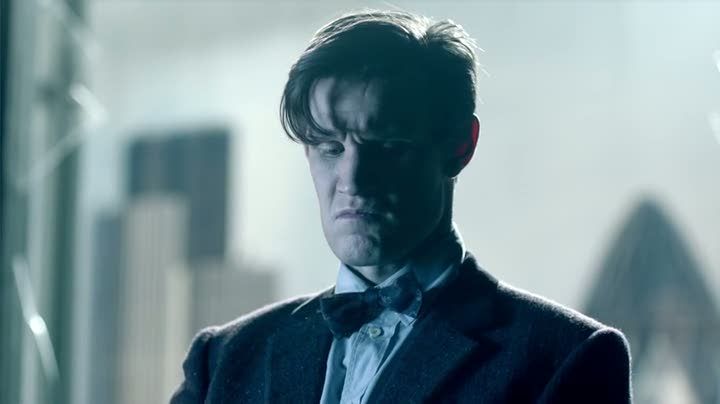
And I love how this is all visually constructed. The helmet which is used to hide his Spoonly nature reflects the image of Miss Kizlet, who's taken the lead in uploading people to a "data-cloud" in the WiFi. Not that he's happy about it -- after he's uploaded Kizlet, he ends up having to use her people-hacking technology to get Mahler to obey the woman's orders to download everybody and wipe the slate clean.
Kizlet's a bit engimatic. Her name, for a starter, seems entirely invented. As we discover, she too has been largely invented, and it's only when she's released that we discover who this "monster" really is: A Little Girl, amongst the shards of The Shard.

Now, yes, it's true that the Little Girl isn't really the monster here, it's The Great Intelligence. But what is the Great Intelligence? What does it mirror, what's it a metaphor for?
I think the answer can be found by looking in the mirrors. In the Reflections.
Like this one:
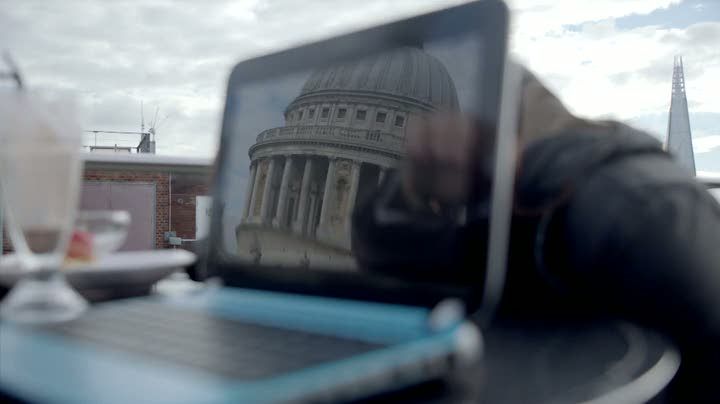
So, with all the fusion imagery of this episode, this near-to-last reflection is rather interesting. Here's Clara fast asleep after her second "death", on the verge of waking up. We see St Paul's Cathedral reflected over half her head -- as if the connotations of "afterlife" implied by this icon have somehow hacked into Clara's head, making her unconscious. The Doctor's hand reaches across the reflection, shutting the Laptop of Doom and removing the mirror-image from its juxtaposition with Clara's head.
Then, and only then, does Clara finally wake up.
End Part One